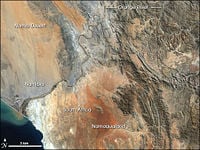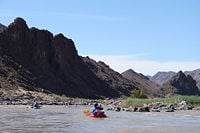Orange River
| Orange | |
|---|---|
| Gariep, Oranje, Senqu | |
Sunset over the Orange River near Upington in the Northern Cape
| |
| Countries | Lesotho, South Africa, Namibia |
| Length | 2,200 km (1,367 miles) |
| Watershed | 973,000 km² (375,677 miles²) |
| Source | Senqu |
| - location | Drakensberg mountains, Lesotho |
| Mouth | Alexander Bay |
| - location | Atlantic Ocean |
| Major tributaries | |
| - right | Caledon River, Vaal River, Fish River (Namibia) |
The course and watershed of the Orange River. This map shows a conservative border for the watershed. Specifically, the Kalahari basin is excluded, as some sources say it is endorheic. [1] Some other sources using computational methods show a basin which includes parts of Botswana (and hence of the Kalahari). [2] | |
The Orange River (Gariep River, Groote River, or Senqu River) is the longest river in South Africa. It rises in the Drakensberg mountains in Lesotho and then flows west through South Africa to the Atlantic Ocean. The river forms part of the international borders between South Africa and Namibia and between South Africa and Lesotho, as well as several provincial borders within South Africa. Although the river does not pass through any major cities, it plays an important role in the South African economy by providing water for irrigation, as well as hydroelectric power. The river has a total length of 1,367 miles (2,200 km).
Geography
The Orange rises in the Drakensberg mountains along the border between South Africa and Lesotho, about 120 miles (193 km) west of the Indian Ocean and at an altitude of over 3000 m. While in Lesotho, the river is known as the Senqu and parts of it freeze in winter because of the altitude there.
The river then runs westward, forming the southwestern boundary of the Free State province. In this section the river flows over the Gariep Dam (the largest in the country) and on to the Vanderkloof Dam. From the border of Lesotho to below the Van der Kloof Dam the river bed is deeply incised. Farther downstream the land is flatter, and the river is used extensively for irrigation.
At the western point of the Free State, southwest of Kimberley, the Orange meets with its main tributary, the Vaal River, which itself forms much of the northern border of the province. From here the river flows farther west through the arid wilderness of the southern Kalahari region and Namaqualand in the Northern Cape Province to meet with Namibia. From here it flows west, forming the international border between the province and Namibia's Karas Region. On the border, the river passes the town of Vioolsdrif, the Customs and Excise post between South Africa and Namibia.
In the last 500 miles (800 km) of its course, the Orange receives many intermittent streams, and several large wadis lead into it. In this section, the Namib Desert terminates on the north bank of the river, so under normal circumstances the volume of water added by these tributaries is negligible. Here the bed of the river is once again deeply incised. The Hundred Falls or Augrabies Falls are located on this section of the Orange, where the river descends 400 feet (122 m) in 16 miles (26 km).
The Orange empties into the Atlantic Ocean at Alexander Bay, which lies about equidistant between Cape Town and Walvis Bay. Some 20 miles (33 km) from its mouth it is completely obstructed by rapids and sand bars and is generally not navigable for long stretches.
Catchment and rainfall
In the dry winter months the volume of the water in the river is considerably reduced because of the rapid run-off and evaporation. At the source of the Orange the rainfall is approximately 2000 mm per annum, but precipitation decreases as the river flows westward; at its mouth rainfall is less than 50 mm per annum. The factors that support evaporation tend to increase in a westerly direction. However, in the wet season (summer) the Orange River becomes an impetuous, brown torrent. The huge mass of sediment carried constitutes a long-term threat to all engineering projects on the river.
The total catchment of the Orange River (including the Vaal) extends over 973,000 square kilometers, i.e., about 77 percent of the land area of South Africa. Approximately 366,000 square kilometers (38 percent) is situated in Lesotho, Botswana, and Namibia.
History
Name of the river
The river was first discovered by indigenous Nama people, who called it the Nu Gariep. [3] The river was named the Orange River by Colonel Robert Gordon, commander of the Dutch East India Company garrison at Cape Town, on a trip to the interior. Gordon named the river in honor of William of Orange. [3] A popular but incorrect belief is that the river was named after the supposedly orange color of its water, as opposed to the color of its tributary, the Vaal River ( 'vaal' being Afrikaans for pale or grey). Since the end of apartheid, the original name, "Gariep," has had greater favor in official correspondence in South Africa, although the name "Orange" has greater international recognition. [3] In Lesotho, where the river rises, it is known as the Senqu River.
Economy
The Orange River plays a major role in supporting agriculture, industry, and mining. To assist in this, two large water schemes have been created, the Orange River Project and the Lesotho Highlands Water Project. There are important deposits of alluvial diamonds along the Orange River and around its mouth. Because of the lack of dangerous animals and high water levels during summer, the river is used for recreational canoeing.
Orange River Project
The Orange River Project (ORP) was one of the largest and most imaginative projects of its kind in South Africa. It was constructed by Verwoerd's government at the height of the apartheid era. The ORP was built to tap the unused water of the Orange River — which, without the Vaal River, represents some 14.1 percent of the total runoff in South Africa — and in the process, to satisfy an increasing demand for water. The main objectives of the project were to:
- stabilize river flow,
- generate and transmit hydroelectric power,
- provide a reliable water supply, and
- give a new lease on life to water-deficient areas in the Eastern Cape, such as the Great Fish and Sundays River valleys.
The Gariep Dam near Colesberg is the main storage structure within the Orange River. From here the water is supplied in two directions: west along the Orange River and south to the Eastern Cape.
Hydroelectricity
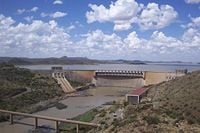
Eskom operates hydroelectric power stations at both the Gariep Dam and the Vanderkloof Dam. The hydro-electric power station at the Vanderkloof Dam was the first power-generation station in South Africa situated entirely underground. The towns Oviston and Oranjekrag were established to facilitate the construction and operation of the new infrastructure.
Irrigation
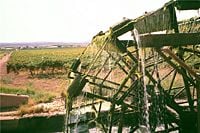
Irrigation in the vast area downstream of the Vanderkloof Dam, which has turned thousands of hectares of arid veld into highly productive agricultural land, was made possible by the construction of the Gariep and Vanderkloof Dams. Old, established irrigation schemes such as those at Buchuberg, Upington, Kakamas, and Vioolsdrif also benefited because regulation of the flow is now possible.
In recent years the wine-producing areas along the Orange River have also grown in importance. Irrigation in the Eastern Cape has also received a tremendous boost, not only from the additional water that is being made available but also owing to improvement in water quality. Without this improvement the citrus farmers along the Lower Sundays River would almost certainly have continued to suffer losses of productivity.
Lesotho Highlands Water Project
The Lesotho Highlands Water Project was conceived to supplement the water supply in the Vaal River System. Water is delivered to South Africa by means of the Delivery Tunnel that passes under the Lesotho-South Africa border at the Caledon River and then under the Little Caledon River south of Clarens in the Free State and discharges into the Ash River about 30 kilometers farther to the north. The scheme became viable when water demands in Gauteng reached levels that could no longer be supported economically by alternative schemes such as the Tugela River-Vaal River pumped storage scheme, which utilized the Sterkfontein Dam, located near Harrismith in the Free State.
Rafting and canoeing
During the temperate months of March and April, given good rains and the sluices of the dams being open, a canoeist (or rafter) can easily travel 30 kilometers per day. The lower reaches of the river are most popular, because of the spectacular topography. The Orange River winds its way through the canyons of Richtersveld National Park with its rapids. Dramatic landscapes with rugged mountain ranges, metamorphosed lava flows, and ice-age deposits sweep away inland from the river, where fish eagles, Egyptian geese, and kingfishers enjoy the fish and the riverine vegetation. Commercial tours are available, and these expeditions depart from the border town of Vioolsdrif.
Notes
- ↑ Swanevelder, C. J. (1981), Utilising South Africa's largest river: The physiographic background to the Orange River scheme, GeoJournal vol 2 supp 2 pg 29-40
- ↑ Revenga, C.; Murray, S.; Abramovitz, J. and Hammond, A . (1998) Watersheds of the world: Ecological value and vulnerability, World Resources Institute, ISBN 1-56973-254-X
- ↑ 3.0 3.1 3.2 Earle, Anton et al (2005), A preliminary basin profile of the Orange/Senqu River (pdf), African Centre for Water Research, retrieved 30 June 2007
External links
- Map of the Orange River basin at Water Resources eAtlas
- Map of portion of Orange River basin forming part of South Africa
- Information on the Orange River from the South African Department of Water Affairs and Forestry
Coordinates:
Credits
New World Encyclopedia writers and editors rewrote and completed the Wikipedia article in accordance with New World Encyclopedia standards. This article abides by terms of the Creative Commons CC-by-sa 3.0 License (CC-by-sa), which may be used and disseminated with proper attribution. Credit is due under the terms of this license that can reference both the New World Encyclopedia contributors and the selfless volunteer contributors of the Wikimedia Foundation. To cite this article click here for a list of acceptable citing formats.The history of earlier contributions by wikipedians is accessible to researchers here:
The history of this article since it was imported to New World Encyclopedia:
Note: Some restrictions may apply to use of individual images which are separately licensed.
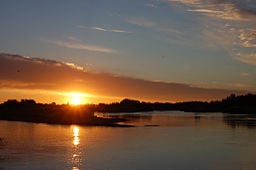
![The course and watershed of the Orange River. This map shows a conservative border for the watershed. Specifically, the Kalahari basin is excluded, as some sources say it is endorheic. [1] Some other sources using computational methods show a basin which includes parts of Botswana (and hence of the Kalahari). [2]](/d/images/thumb/0/02/Orange_watershed_topo.png/256px-Orange_watershed_topo.png)
